Spatial Distribution Characteristics and Influential Factors of Major Towns in Guizhou Province Analyzed with ArcGIS
Abstract
1. Introduction
2. Overview of the Study Area and Data Sources
2.1. Study Area Overview
2.2. Data Sources
3. Examination of the Spatial Distribution Attributes of Leading Towns in Guizhou Province
3.1. Overview of Spatial Distribution
3.2. Categories of Major Towns
3.3. Concentration of Spatial Distribution
3.4. Spatial Distribution Density
3.5. Type of Spatial Distribution
4. Analysis of the Factors Influencing the Spatial Distribution of Major Towns in Guizhou Province
4.1. Road Network
4.2. Natural Environmental Conditions
4.2.1. Terrain and Topography
4.2.2. Endowment of Tourism Resources
4.2.3. Endowment of Humanistic Resources
4.3. Government Policy Support
5. Conclusions and Future Work
5.1. Conclusion
- (1)
- The number and distribution of major cities and towns within each city and state in Guizhou Province are not substantially disparate, yet certain regions reveal agglomerative tendencies, generating an urban spatial order characterized by a “one core, one group, two circles, six groups, and multiple points”;
- (2)
- The geographic concentration index (z = 33.33% per state and city in Guizhou Province, and z = 35.46% for major towns in Guizhou Province) reflects that the factual geographic concentration index for major towns in Guizhou Province exceeds both the average distribution of major towns and the geographic concentration index of each state and city. As a result, it indicates that major towns within Guizhou Province are centralized and dispersed;
- (3)
- The road transportation system exerts a substantial influence on the distribution and evolution of diverse functional towns within Guizhou Province, and the spatial structure of towns is disseminated along a point-axis distribution, with a high degree of spatial coincidence with the transportation axis. The natural environmental conditions, human-tourism resource endowments, and their respective distributions serve as the conditions and basis for the development of major towns in Guizhou Province. Moreover, policy incentives exert a significant impact on the distribution and progression of major towns in Guizhou Province.
5.2. Future Work
- (1)
- The government must meticulously plan out the layout of major towns to foster the unique growth of prominent core urban clusters and prevent redundant construction;
- (2)
- Enhancing transportation and infrastructure, leveraging existing transportation conditions to promote the development of varied functional towns, and strengthening their linkage to neighboring cities to cultivate a driving development pattern;
- (3)
- Culture is the heart and soul of town development, especially within the tourism service town sector. Planning must harness the influence of culture, highlight distinctiveness, and balance historical and contemporary aspects;
- (4)
- Embracing the principle of integrated development of “distinctiveness”, “environmental sustainability”, and “harmonious coexistence”, fully exploiting the “distinctiveness” of diverse functional towns, and capitalizing on regional resource advantages to guarantee the sustainable and wholesome advancement of towns.
Author Contributions
Funding
Institutional Review Board Statement
Informed Consent Statement
Data Availability Statement
Conflicts of Interest
References
- Webb, J.W. Basic concepts in the analysis of small urban centers of minnesota. Ann. Assoc. Am. Geogr. 1959, 49, 55–72. [Google Scholar] [CrossRef]
- Berry, B.J.L. City Size Distribution and Economic Development. Econ. Dev. Cult. Chang. 1961, 9, 573–588. [Google Scholar]
- Berry, B.J.L. Cities as systems within systems of cities. Pap. Reg. Sci. 1964, 13, 147–163. [Google Scholar] [CrossRef]
- Berry, B.J.L.; Okulicz-Kozaryn, A. The city size distribution debate: Resolution for US urban regions and megalopolitan areas. Cities 2012, 29, S17–S23. [Google Scholar] [CrossRef]
- Alperovich, G. The size distribution of cities: On the empirical validity of the rank-size rule. J. Urban Econ. 1984, 16, 232–239. [Google Scholar] [CrossRef]
- Svensson, M.K.; Thorsson, S.; Lindqvist, S. A geographical information system model for creating bioclimatic maps—Examples from a high, mid-latitude city. Int. J. Biometeorol. 2003, 47, 102–112. [Google Scholar] [CrossRef]
- Deng, C.F.; Ji, J.J. The Flexible Spatial Structure Planning of Cities under Uncertainty Development. AMM 2012, 209, 526–530. [Google Scholar] [CrossRef]
- Zagroba, M.; Pawlewicz, K.; Senetra, A. Analysis and Evaluation of the Spatial Structure of Cittaslow Towns on the Example of Selected Regions in Central Italy and North-Eastern Poland. Land 2021, 10, 780. [Google Scholar] [CrossRef]
- Gould, P. Review of Locational Analysis in Human Geography. Geogr. Rev. 1967, 57, 292–294. [Google Scholar] [CrossRef]
- Kusnierz-Krupa, D. Issue of Protecting Historic Urban Layouts of Small Towns in South-Eastern Poland—On Selected Examples. IOP Conf. Ser. Mater. Sci. Eng. 2019, 471, 082034. [Google Scholar] [CrossRef]
- Thilagam, N.L.; Banerjee, U.K. The morphological characteristics of medieval temple towns of Tamilnadu. Environ. Plan. B Plan. Des. 2016, 43, 7–33. [Google Scholar] [CrossRef]
- Musiaka, Ł.; Sudra, P.; Spórna, T. Spatial Chaos as a Result of War Damage and Post-War Transformations. Example of the Small Town of Węgorzewo. Land 2021, 10, 541. [Google Scholar] [CrossRef]
- Baumanova, M.; Smejda, L.; Rüther, H. Pre-Colonial Origins of Urban Spaces in the West African Sahel: Street Networks, Trade, and Spatial Plurality. J. Urban Hist. 2019, 45, 500–516. [Google Scholar] [CrossRef]
- Nie, R.; Zeng, J.; Zhao, X.P. Spatial Design Research for Urban Mitigation to Strength Urban Resilience. Adv. Mater. Res. 2011, 368, 3388–3391. [Google Scholar] [CrossRef]
- Xu, Y.; Rollo, J.; Jones, D.S.; Esteban, Y.; Tong, H.; Mu, Q. Towards Sustainable Heritage Tourism: A Space Syntax-Based Analysis Method to Improve Tourists’ Spatial Cognition in Chinese Historic Districts. Buildings 2020, 10, 29. [Google Scholar] [CrossRef]
- Lin, C.; Cheng, H. Renaissance of the Old Town District in Tainan: Research on Aesthetic Zoning in Historic Districts. J. Asian Archit. Build. Eng. 2008, 7, 317–324. [Google Scholar] [CrossRef]
- Niu, S.; Hu, A.; Shen, Z.; Lau, S.S.Y.; Gan, X. Study on land use characteristics of rail transit TOD sites in new towns—Taking Singapore as an example. J. Asian Archit. Build. Eng. 2019, 18, 16–27. [Google Scholar] [CrossRef]
- Zagroba, M.; Pawlowicz, J. Selected Aspects of Revitalisation in the Land Development of the City Moat in Jeziorany. IOP Conf. Ser. Mater. Sci. Eng. 2019, 603, 052073. [Google Scholar] [CrossRef]
- Hwang, R.-L.; Lin, C.-Y.; Huang, K.-T. Spatial and temporal analysis of urban heat island and global warming on residential thermal comfort and cooling energy in Taiwan. Energy Build. 2017, 152, 804–812. [Google Scholar] [CrossRef]
- Wang, F.; Liu, X.; Jiang, B.; Zhuo, H.; Chen, W.; Chen, Y.; Li, X. Low-loading Pt nanoparticles combined with the atomically dispersed FeN4 sites supported by FeSA-N-C for improved activity and stability towards oxygen reduction reaction/hydrogen evolution reaction in acid and alkaline media. J. Colloid Interface Sci. 2023, 635, 514–523. [Google Scholar] [CrossRef]
- Li, Q.; Zhao, D.; Yin, J.; Zhou, X.; Li, Y.; Chi, P.; Han, Y.; Ansari, U.; Cheng, Y. Sediment Instability Caused by Gas Production from Hydrate-bearing Sediment in Northern South China Sea by Horizontal Wellbore: Evolution and Mechanism. Nat. Resour. Res. 2023, 32, 1595–1620. [Google Scholar] [CrossRef]
- Li, Q.; Zhang, C.; Yang, Y.; Ansari, U.; Han, Y.; Li, X.; Cheng, Y. Preliminary experimental investigation on long-term fracture conductivity for evaluating the feasibility and efficiency of fracturing operation in offshore hydrate-bearing sediments. Ocean Eng. 2023, 281, 114949. [Google Scholar] [CrossRef]
- Kwak, Y.; Park, C.; Deal, B. Discerning the Success of Sustainable Planning: A Comparative Analysis of Urban Heat Island Dynamics in Korean New Towns. Sustain. Cities Soc. 2020, 61, 102341. [Google Scholar] [CrossRef]
- Wang, L. China’s new town movements since 1949: A state/space perspective. Prog. Plan. 2020, 155, 100514. [Google Scholar] [CrossRef]
- Zou, Y. Capital switching, spatial fix, and the paradigm shifts of China’s urbanization. Urban Geogr. 2021, 43, 1662–1682. [Google Scholar] [CrossRef]
- Chen, Y.; Bing, H.; Zhang, L.G. The Marshlands Degradation and the Urban Spatial Transformation: A Case Study of “Town” and “Market” in Jingzhou City. Adv. Mater. Res. 2012, 599, 943–949. [Google Scholar] [CrossRef]
- Gu, X.; Tao, S.; Dai, B. Spatial Accessibility of Country Parks in Shanghai, China. Urban For. Urban Green. 2017, 27, 373–382. [Google Scholar] [CrossRef]
- Jing, C. Quantitative Evaluation of Spatial Differentiation for Public Open Spaces in Urban Built-Up Areas by Assessing SDG 11.7: A Case of Deqing County. ISPRS Int. J. Geo-Inf. 2020, 9, 575. [Google Scholar]
- Geng, H.; Qiao, J. Assessment of Small Towns’ Fitness around China’s Major Cities: A Case Study in Wuhan City. Sustainability 2018, 10, 2154. [Google Scholar] [CrossRef]
- Dai, J.; Fan, B.; Wang, J.; Wang, Y. Interference of Urban Spatial Evolution to Wetland Ecosystem; Spin-Int Soc Optical Engineering: Cairo, Egypt, 2011; p. 82852F. [Google Scholar]
- Li, J.; Chiu, R.L.H. State rescaling and large-scale urban development projects in China: The case of Lingang New Town, Shanghai. Urban Stud. 2020, 57, 2564–2581. [Google Scholar] [CrossRef]
- Wei, K. Analyzing Hierarchy Spatial Structure of Chinese Ancient Town. In Proceedings of the International Conference on Civil Engineering, Architecture and Building Materials, Kunming, China, 26–28 July 2011. [Google Scholar]
- Tao, H.; Huang, Z.; Ran, F. Rural Tourism Spatial Reconstruction Model from the Perspective of ATV: A Case Study of Mufu Township, Hubei Province, China. Sustainability 2018, 10, 2675. [Google Scholar] [CrossRef]
- Zhou, H.; Li, B.H.; Xiao, Q. A Study on Spatial Forms Characteristic of the Historic Towns in Yuan River Basin. Appl. Mech. Mater. 2011, 71, 3639–3642. [Google Scholar] [CrossRef]
- Wang, L.; Yao, P. Analysis of the Landscape Space Evolution Characteristics in Sichuan Qijiang Historical Town. In Proceedings of the International Conference on Civil Engineering, Architecture and Building Materials, Yantai, China, 25–27 May 2012. [Google Scholar]
- Ding, A.; Cenci, J.; Zhang, J. Links between the pandemic and urban green spaces, a perspective on spatial indices of landscape garden cities in China. Sustain. Cities Soc. 2022, 85, 104046. [Google Scholar] [CrossRef] [PubMed]
- Zhan, Z.; Cenci, J.; Zhang, J. Frontier of Rural Revitalization in China: A Spatial Analysis of National Rural Tourist Towns. Land 2022, 11, 812. [Google Scholar] [CrossRef]
- Xie, Y.; Meng, X.; Cenci, J.; Zhang, J. Spatial Pattern and Formation Mechanism of Rural Tourism Resources in China: Evidence from 1470 National Leisure Villages. IJGI 2022, 11, 455. [Google Scholar] [CrossRef]
- Yang, C.; Huang, J.; Lin, Z.; Zhang, D.; Zhu, Y.; Xu, X.; Chen, M. Evaluating the symbiosis status of tourist towns: The case of Guizhou Province, China. Ann. Tour. Res. 2018, 72, 109–125. [Google Scholar] [CrossRef]
- Gao, S.; Yang, L.; Jiao, H. Changes in and Patterns of the Tradeoffs and Synergies of Production-Living-Ecological Space: A Case Study of Longli County, Guizhou Province, China. Sustainability 2022, 14, 8910. [Google Scholar] [CrossRef]
- Li-Ming, Z.; Hong-Bo, C. On Tourism Destination Concentration Based on Space Lorenz Curve—Taking Korean Tourists as an Example. J. Xiangtan Univ. (Philos. Soc. Sci.) 2009, 33, 147–151. [Google Scholar]
- Yang, R.; Xu, Q.; Long, H. Spatial distribution characteristics and optimized reconstruction analysis of China’s rural settlements during the process of rapid urbanization. J. Rural Stud. 2016, 47, 413–424. [Google Scholar] [CrossRef]
- Wang, X.; Xi, J.; Yang, D.; Chen, T. Spatial Differentiation of Rural Touristization and Its Determinants in China: A Geo-Detector-Based Case Study of Yesanpo Scenic Area. J. Resour. Ecol. 2016, 7, 464–471. [Google Scholar]
- Shen, J.; Zhang, N.; Gexigeduren; He, B.; Liu, C.-Y.; Li, Y.; Zhang, H.-Y.; Chen, X.-Y.; Lin, H. Construction of a GeogDetector-based model system to indicate the potential occurrence of grasshoppers in Inner Mongolia steppe habitats. Bull. Entomol. Res. 2015, 105, 335–346. [Google Scholar] [CrossRef]
- Zhang, N.; Jing, Y.-C.; Liu, C.-Y.; Li, Y.; Shen, J. A cellular automaton model for grasshopper population dynamics in Inner Mongolia steppe habitats. Ecol. Model. 2016, 329, 5–17. [Google Scholar] [CrossRef]
- Johnson, S.C. Hierarchical clustering schemes. Psychometrika 1967, 32, 241–254. [Google Scholar] [CrossRef] [PubMed]
- King, L.J. Statistical Analysis in Geography; Prentice-Hall: Hoboken, NJ, USA, 1969. [Google Scholar]
- Clark, P.J.; Evans, F.C. Distance to Nearest Neighbor as a Measure of Spatial Relationships in Populations. Ecology 1954, 35, 445–453. [Google Scholar] [CrossRef]
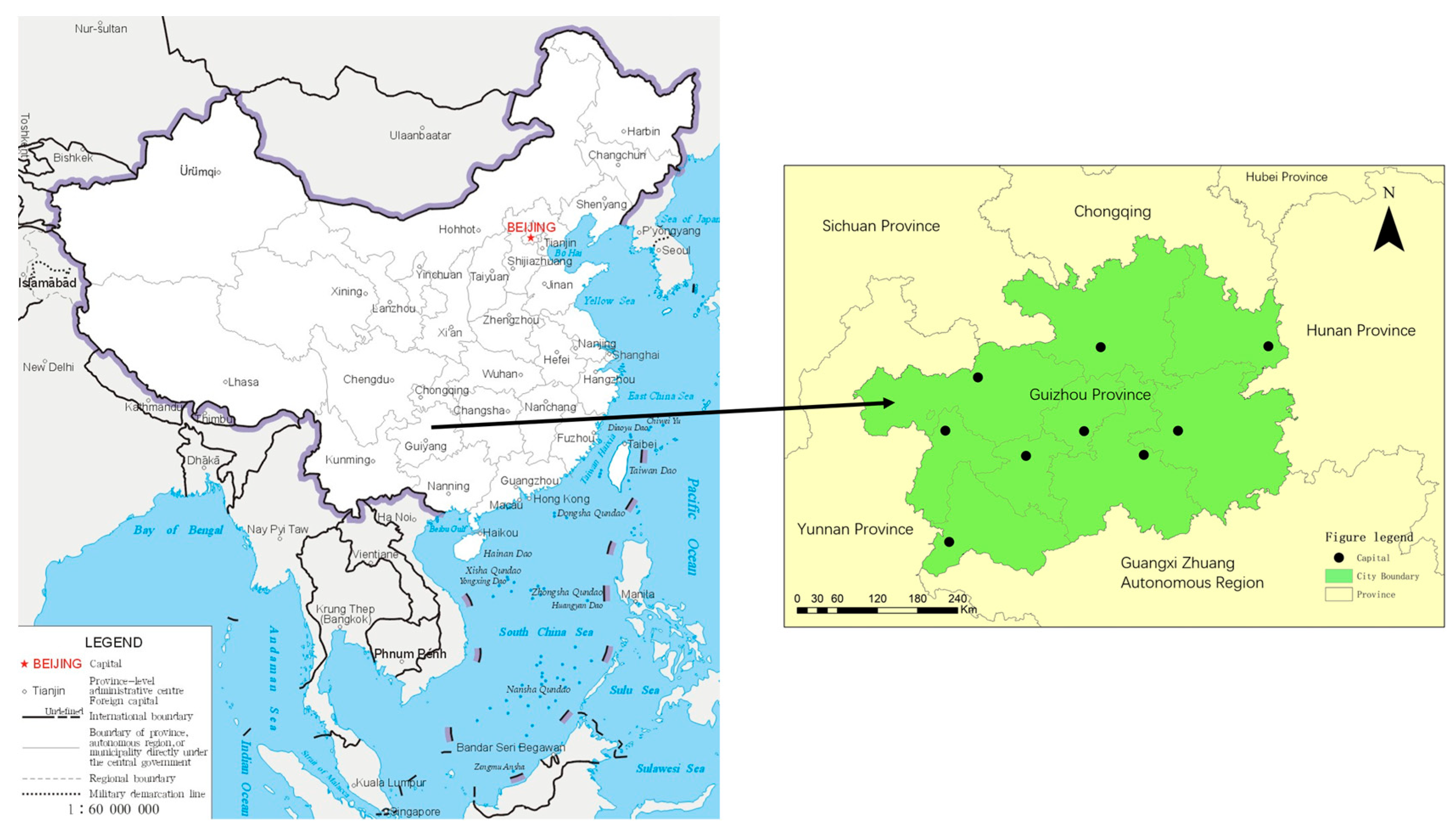
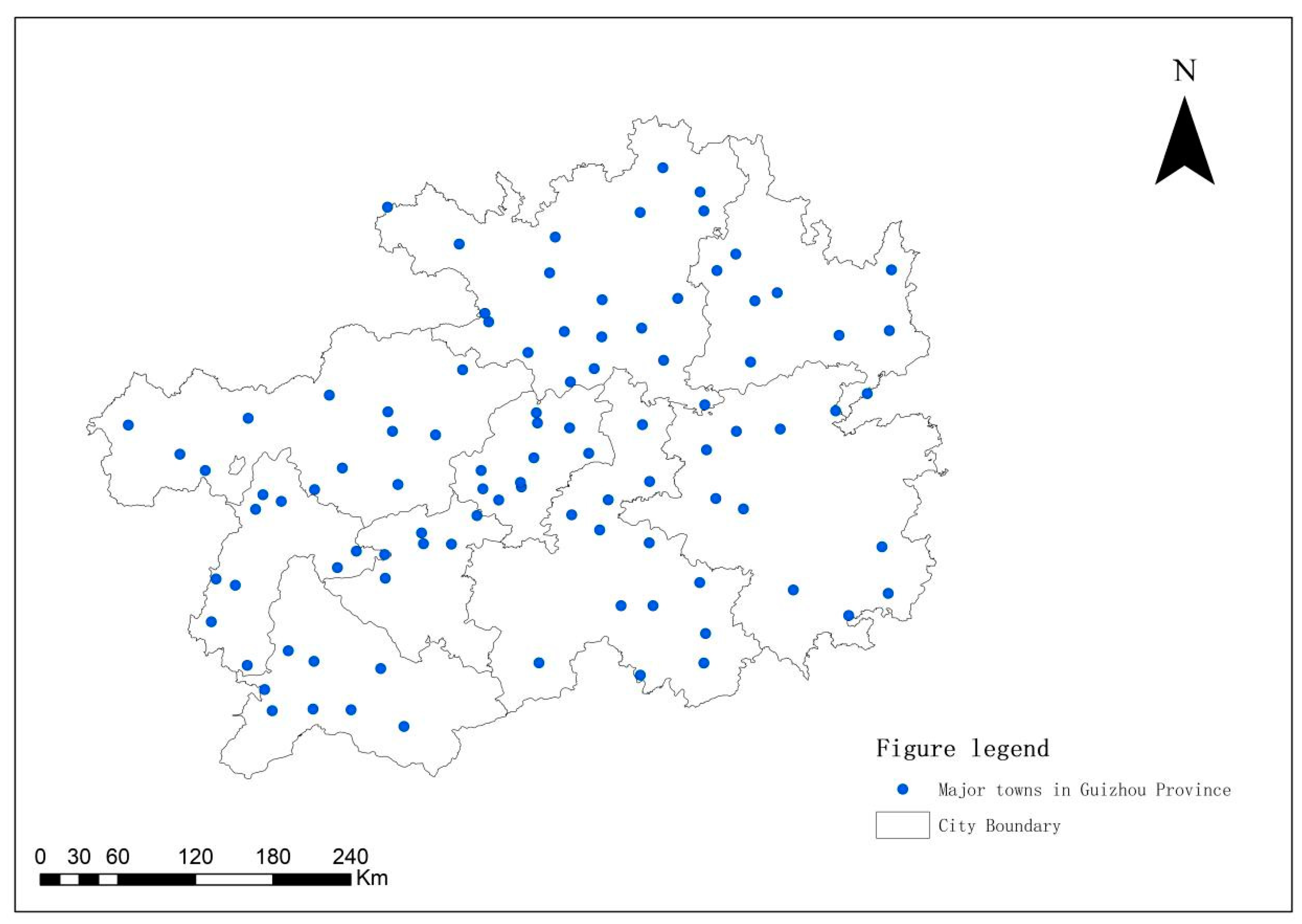
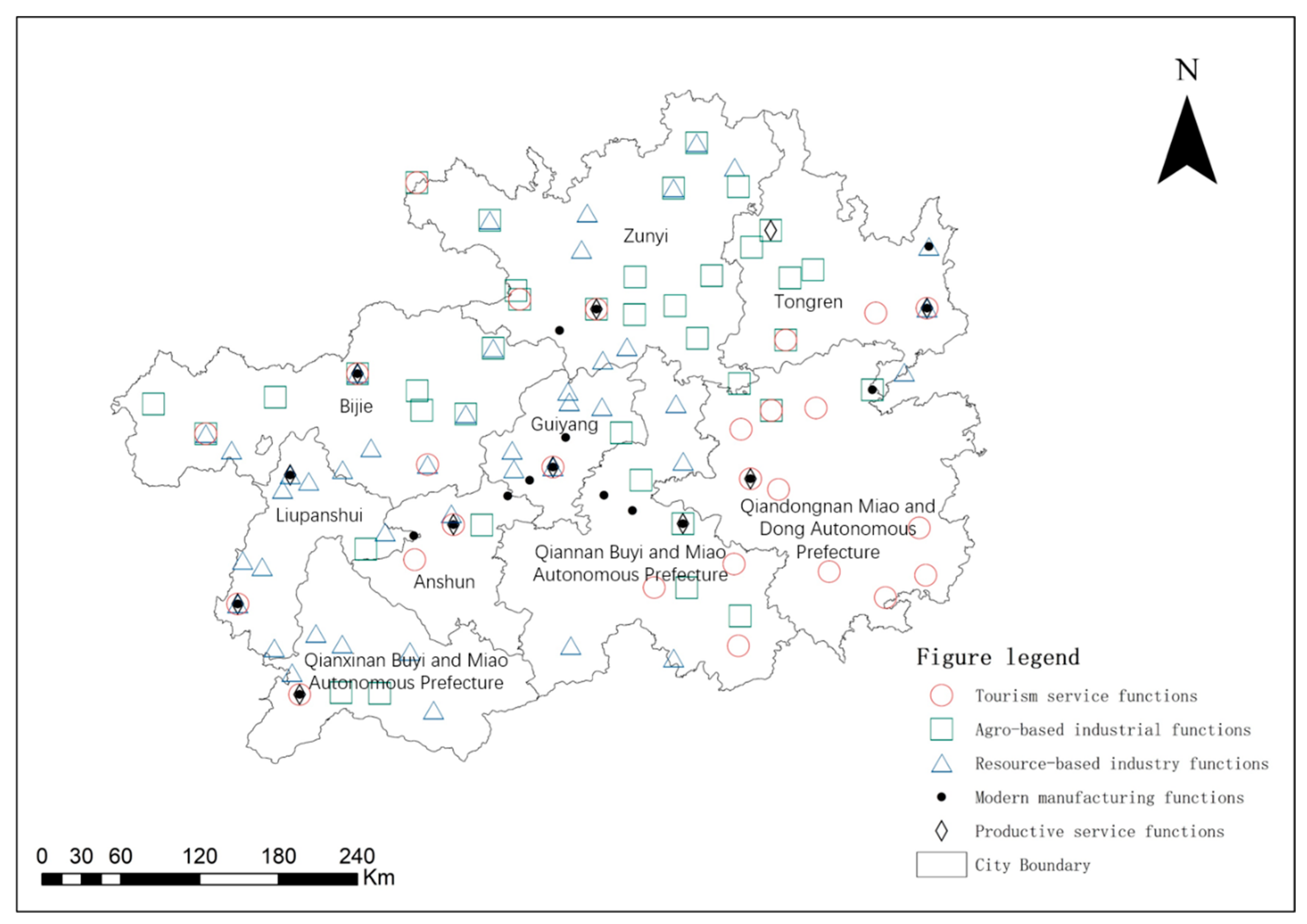
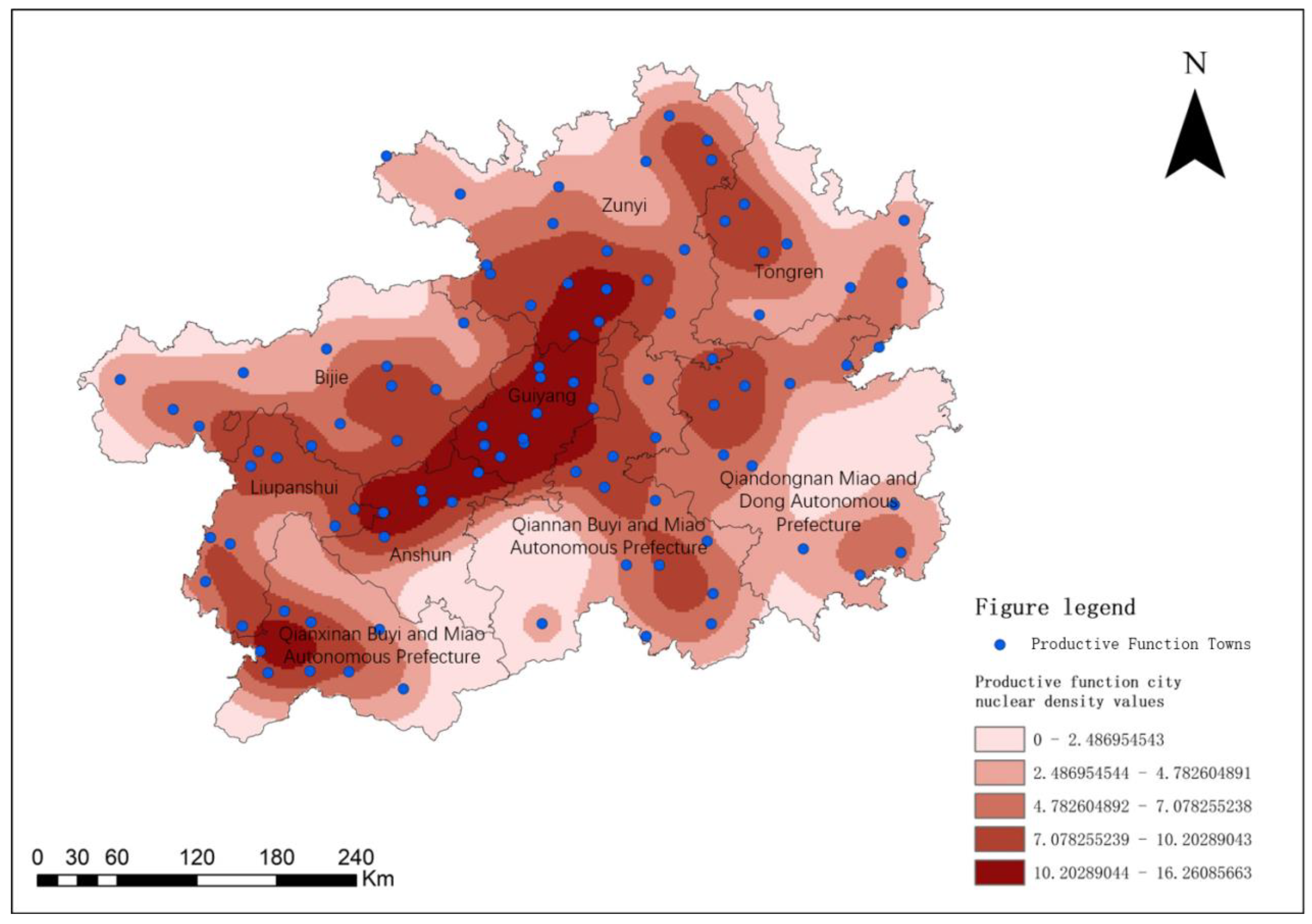

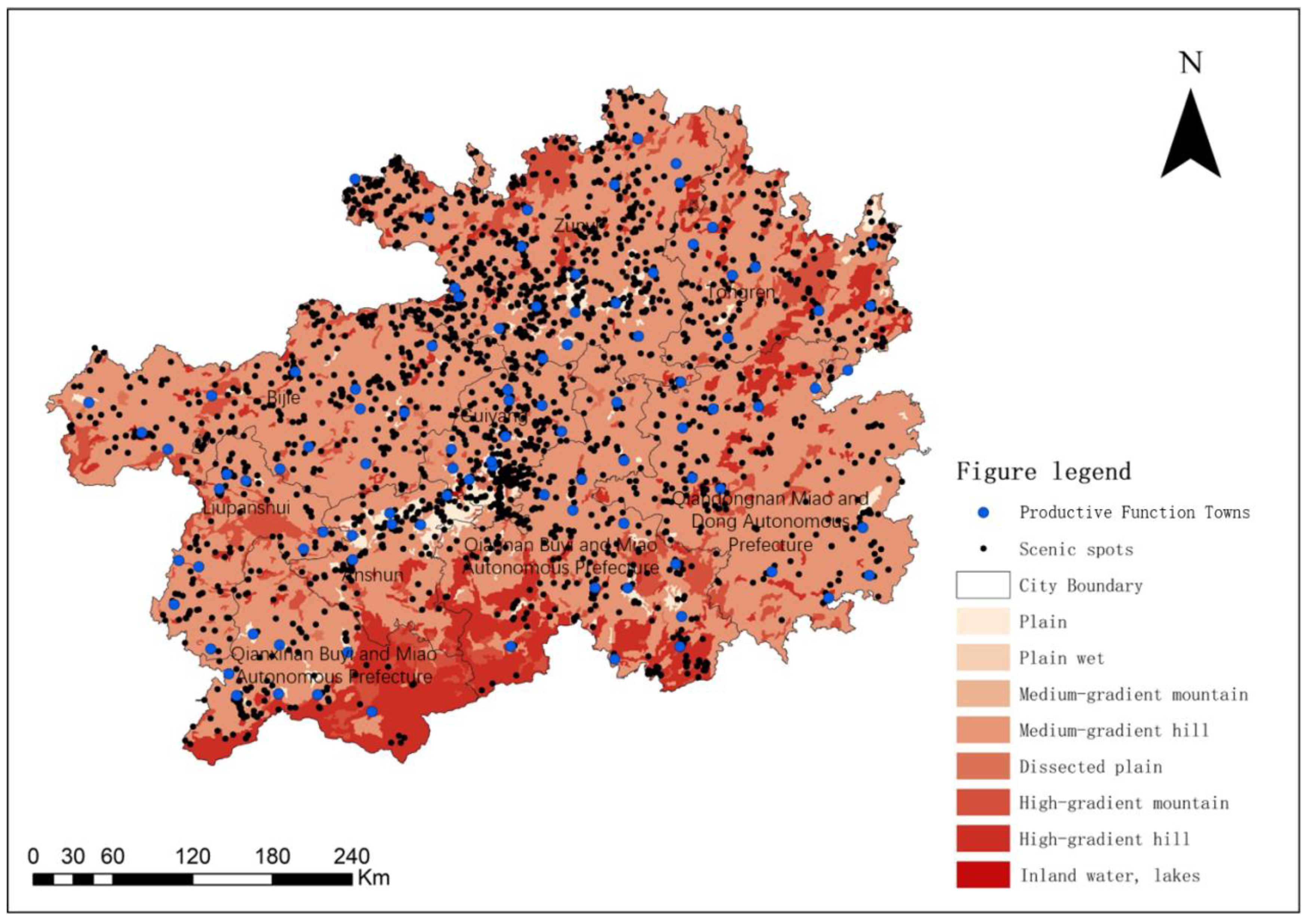
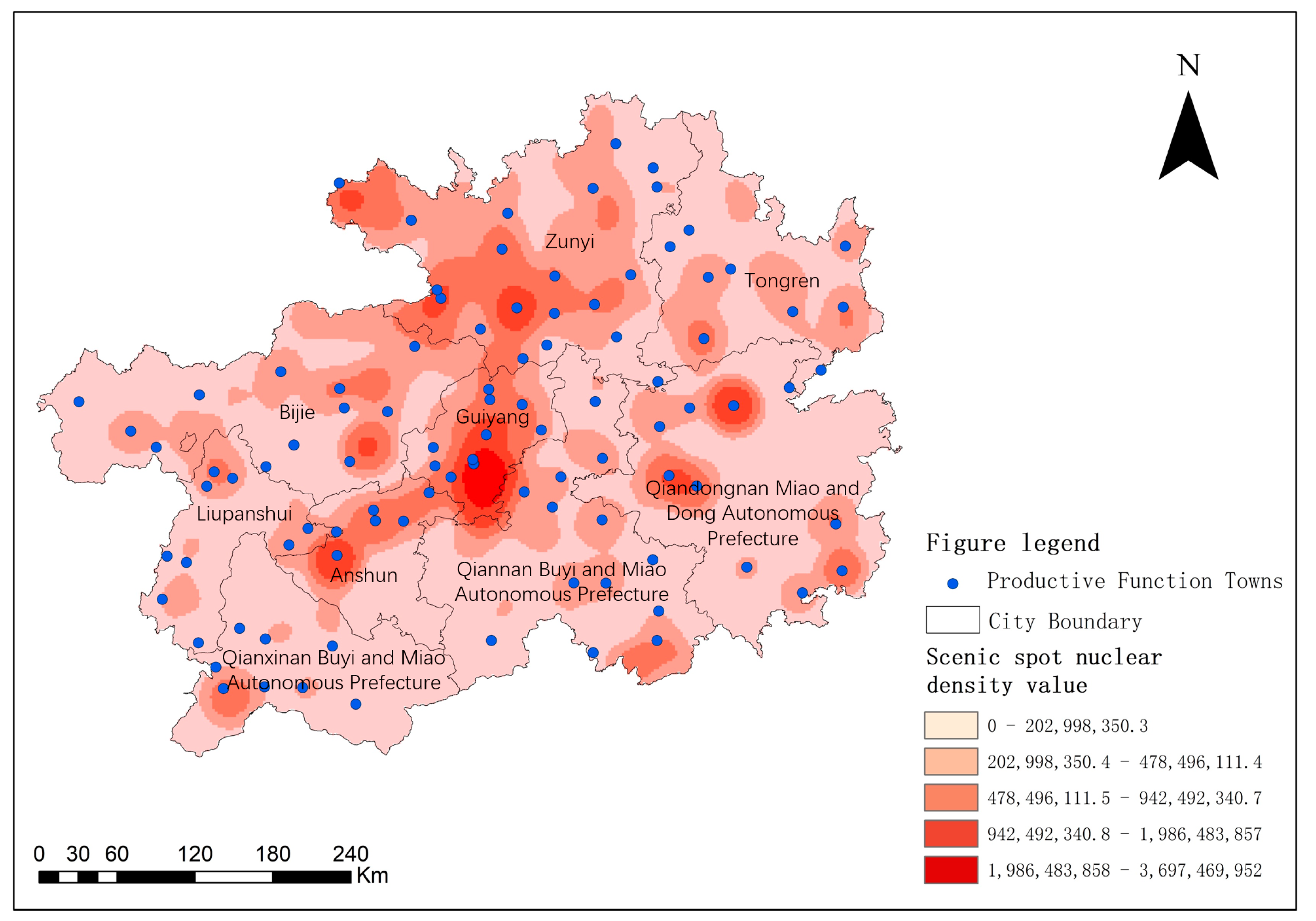
Disclaimer/Publisher’s Note: The statements, opinions and data contained in all publications are solely those of the individual author(s) and contributor(s) and not of MDPI and/or the editor(s). MDPI and/or the editor(s) disclaim responsibility for any injury to people or property resulting from any ideas, methods, instructions or products referred to in the content. |
© 2023 by the authors. Licensee MDPI, Basel, Switzerland. This article is an open access article distributed under the terms and conditions of the Creative Commons Attribution (CC BY) license (https://creativecommons.org/licenses/by/4.0/).
Share and Cite
Liu, C.; Pan, H.; Wei, Y. Spatial Distribution Characteristics and Influential Factors of Major Towns in Guizhou Province Analyzed with ArcGIS. Sustainability 2023, 15, 10764. https://doi.org/10.3390/su151410764
Liu C, Pan H, Wei Y. Spatial Distribution Characteristics and Influential Factors of Major Towns in Guizhou Province Analyzed with ArcGIS. Sustainability. 2023; 15(14):10764. https://doi.org/10.3390/su151410764
Chicago/Turabian StyleLiu, Caiqing, Huifeng Pan, and Yurong Wei. 2023. "Spatial Distribution Characteristics and Influential Factors of Major Towns in Guizhou Province Analyzed with ArcGIS" Sustainability 15, no. 14: 10764. https://doi.org/10.3390/su151410764
APA StyleLiu, C., Pan, H., & Wei, Y. (2023). Spatial Distribution Characteristics and Influential Factors of Major Towns in Guizhou Province Analyzed with ArcGIS. Sustainability, 15(14), 10764. https://doi.org/10.3390/su151410764




